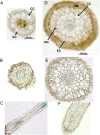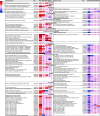Upgrading root physiology for stress tolerance by ectomycorrhizas: insights from metabolite and transcriptional profiling into reprogramming for stress anticipation
- PMID: 19812185
- PMCID: PMC2785981
- DOI: 10.1104/pp.109.143735
Upgrading root physiology for stress tolerance by ectomycorrhizas: insights from metabolite and transcriptional profiling into reprogramming for stress anticipation
Abstract
Ectomycorrhizas (EMs) alleviate stress tolerance of host plants, but the underlying molecular mechanisms are unknown. To elucidate the basis of EM-induced physiological changes and their involvement in stress adaptation, we investigated metabolic and transcriptional profiles in EM and non-EM roots of gray poplar (Populus x canescens) in the presence and absence of osmotic stress imposed by excess salinity. Colonization with the ectomycorrhizal fungus Paxillus involutus increased root cell volumes, a response associated with carbohydrate accumulation. The stress-related hormones abscisic acid and salicylic acid were increased, whereas jasmonic acid and auxin were decreased in EM compared with non-EM roots. Auxin-responsive reporter plants showed that auxin decreased in the vascular system. The phytohormone changes in EMs are in contrast to those in arbuscular mycorrhizas, suggesting that EMs and arbuscular mycorrhizas recruit different signaling pathways to influence plant stress responses. Transcriptome analyses on a whole genome poplar microarray revealed activation of genes related to abiotic and biotic stress responses as well as of genes involved in vesicle trafficking and suppression of auxin-related pathways. Comparative transcriptome analysis indicated EM-related genes whose transcript abundances were independent of salt stress and a set of salt stress-related genes that were common to EM non-salt-stressed and non-EM salt-stressed plants. Salt-exposed EM roots showed stronger accumulation of myoinositol, abscisic acid, and salicylic acid and higher K(+)-to-Na(+) ratio than stressed non-EM roots. In conclusion, EMs activated stress-related genes and signaling pathways, apparently leading to priming of pathways conferring abiotic stress tolerance.
Figures





References
-
- Anastasiou E, Kenz S, Gerstung M, MacLean D, Timmer J, Fleck C, Lenhard M (2007) Control of plant organ size by KLUH/CYP78A5-dependent intercellular signaling. Dev Cell 13 843–856 - PubMed
-
- Barker S, Tagu D (2000) The roles of auxins and cytokinins in mycorrhizal symbioses. J Plant Growth Regul 19 144–154 - PubMed
-
- Beckers GJM, Conrath U (2007) Priming for stress resistance: from the lab to the field. Curr Opin Plant Biol 10 425–431 - PubMed
-
- Benning C (1998) Biosynthesis and function of the sulfolipid sulfoquinovosyl diacylglycerol. Annu Rev Plant Physiol Plant Mol Biol 49 53–75 - PubMed
Publication types
MeSH terms
Substances
LinkOut - more resources
Full Text Sources
Molecular Biology Databases

